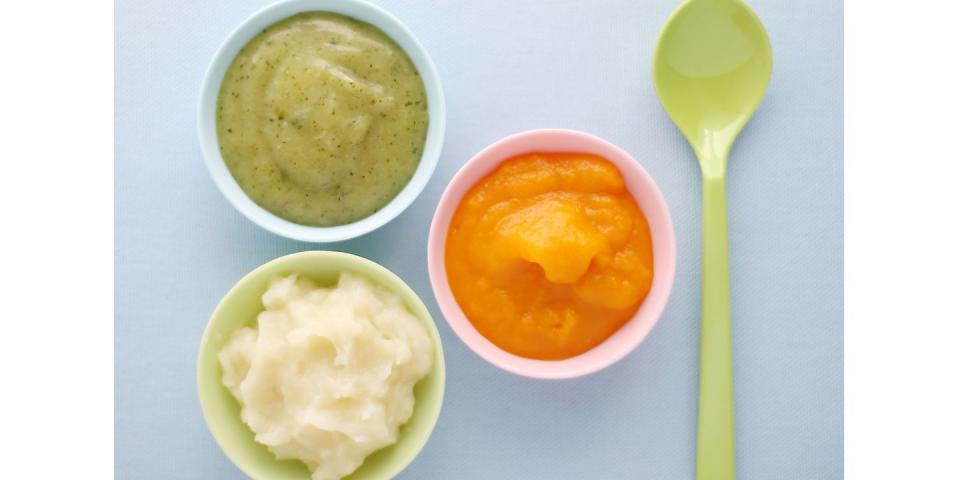Weaning: a beginner’s guide

As your baby approaches the six month mark, your thoughts will no doubt start turning to weaning. But while introducing your little one to solid foods is an exciting new adventure for both of you, it can sometimes leave a new parent feeling confused and even anxious.
When is the right time to get started? Should you make up purées or opt for a baby-led approach? How much should you be offering your baby? Which foods should you introduce first – and how? And what if you have concerns about inherited food allergies?
If these questions – and more – have been on your mind, take a deep breath and read on. We’ve asked the experts to help answer all your queries.
How can you tell your baby is ready for weaning?
You’ve likely heard it’s best to start introducing your baby to solid foods when they’re six months of age. But why?
Dr Frankie Phillips, registered independent nutritionist and dietitian, explains there are three key signs that your baby is ready to start weaning. These are:
Baby is able to stay in a sitting position with their head held steady, for a few seconds at least
Baby has enough hand-eye co-ordination to look at food, pick it up and put it in their mouth
Baby has lost the tongue-thrust reflex, so they can swallow food rather than spitting it back out
‘These signs tend to appear together at around six months,’ explains Dr Phillips, ‘so that's when the World Health Organisation (WHO) advises is the best time to start introducing solids or “complementary” foods.’
Weaning: first foods
When you’re confident your baby is ready, you can start preparing their first foods.
‘The best scientific evidence now recommends that you introduce vegetables as baby’s first tastes,’ reveals Dr Phillips. ‘Introduce a single vegetable at a time initially, so that baby’s precious palate learns to recognise individual flavours.’
Dr Phillips says the following are great first options for baby:
Parsnip
Broccoli
Sweet potato
Butternut squash
Carrot
‘All work well either as a purée, mashed or soft cooked sticks,’ she says. ‘First fruits to try could be cooked apple or pear. You can also introduce baby rice, mixed with your baby’s usual milk – either breast milk or formula.’
Once your baby has tried their first tastes, it’s important to introduce new foods on a regular basis, to help develop their palate. As with everything in life, variety is key!
‘Whilst being fed with breast or formula milk, a baby’s palate will be used to plain flavours with a hint of sweetness – although breastmilk is more variable in its taste, as it will have slight hints of some of the foods mum has eaten,’ says Emily Day, head of food development at Organix. ‘So, when a child is first introduced to solids, the introduction of new flavours can be met with surprise and even reluctance, especially to foods with a more challenging taste, such as bitterness.
‘To ensure babies grow up accepting a wide range of flavours and different foods, it’s important to give them lots of variety from the start. It’s also important that the flavours are not masked with salt or sugar. As they grow, a baby’s food habits will become more entrenched, as they identify the foods they do and don’t like, so it’s important to get them on the right track from the initial stages of weaning and give them a healthy diet into adulthood.’

What is baby-led weaning?
Of course, there’s no need to spend hours puréeing foods if you’d rather not! Baby-led weaning is a tried-and-trusted method that allows baby to feed themselves right from the start, helping to encourage independence and autonomy.
‘Baby-led weaning has been around for a long time,’ says Dr Philips. ‘It generally means offering your baby only finger foods, which they can feed themselves from the start, rather than offering puréed or mashed foods on a spoon. You can offer a range of finger-sized pieces of food, using the same principles of cooked vegetable or fruit pieces to start with. Some people prefer to take this approach for their babies, and health visitors support either, or even a combination of the two, with some foods on a spoon alongside finger foods, which can encourage independence and coordination. There’s no right or wrong way, as long as baby eats a wide variety of foods.’
How much food should you offer baby?
Many new parents become anxious their baby isn’t eating enough at first, but try to relax. It’s important to take it very slowly to begin with – remember, babies only have very small stomachs!
‘At first, you only need to offer the tiniest amounts – just one or two teaspoons, once a day, when baby is fully awake and you feel relaxed,’ says Dr Phillips. ‘Lots of people find mid-morning or lunchtime works well, building up to add in other mealtimes alongside milk feeds. But it’s important to do what works well for your family. There’s no strict order here.’
Catherine Dodd, managing director of Doddl, agrees on the importance of not overfeeding your baby.
‘Babies don’t need large portions, especially when you’re first starting out on the weaning journey,’ she says. ‘Always look for signs your baby is finished, to avoid overfeeding.’
Dodd explains these signs include:
Turning their head away
Holding the spoon as you try to feed them
Keeping their mouth closed
If your baby is displaying these signs, don’t push on with the meal: it will only cause distress… for both baby and you!
‘Babies are really good at knowing when they’ve had enough, so if your baby starts clamping up their mouth, turning their head away or fussing when you offer more food, respond to these cues,’ agrees Dr Phillips. ‘For babies who are self-feeding or baby-led weaning, they might just stop picking up the next mouthful and be ready to do something else. It can be frustrating at times when you’ve prepared some lovely food for them and they don’t want to eat it all, but that’s OK – babies’ appetites vary a lot from day to day, and tomorrow they might want to eat more than you expected.’
Because babies are great at self-regulating their appetite, try not to worry about whether your baby is eating enough: they probably are!
‘Babies should more or less follow the appropriate line on their growth chart, and this is a great and reassuring way to check baby is eating enough,’ says Dr Phillips.

Weaning and family meals
Making up purées or meals for baby while also having to cook separate meals for the rest of the family can become quite time consuming, so it’s great to know that baby can join in with family meals, pretty much from the start.
‘From day one, baby can eat foods that everyone else in the family is enjoying,’ reveals Dr Phillips. ‘So if you’re preparing dinner and carrots are on the menu for baby, everyone else can have carrots with their meal, too. It’s all about role modelling that food is enjoyable for the whole family.’
Dodd agrees that family mealtimes and routines play a big part in role modelling for baby, ensuring they grow up feeling relaxed and happy around foods.
‘Good eating habits start early and the best way for babies to learn is through enjoying mealtimes with the rest of the family,’ she says. ‘The very act of sitting together to eat, undistracted by TV, mobile phones or toys, will help to promote good eating habits.’
Before long, baby will be able to enjoy the same food as the rest of the family, too.
‘At first, some textures might be a bit too advanced, but by the age of 12 months, babies should be eating mixed family foods like everyone else,’ says Dr Phillips.
Salt and sugar
When introducing foods to your baby, it’s important to remember these should never include added sugar or salt.
‘A developing baby’s palate is precious and what we feed our little ones in the early months of weaning can have a lifelong impact on their palate,’ explains Day. ‘If you introduce foods with added salt, a flavour which is naturally palatable to babies whose palates are just starting to develop, it could lead to an unhealthy relationship with salty food later down the line.
‘Instead, it’s important that children grow up tasting and learning about natural flavours of a variety of ingredients, so they can develop a healthy relationship with food. Not only can too much salt, free or added sugars, saturated fats and unnecessary ingredients distort the natural flavours of the food, they can also influence later eating habits.’
Obviously new parents won’t all have time to create homemade snack for those times when you’re out and about with baby, so always opt for dedicated baby products, rather than snacks designed for older children or adults.
Weaning and food allergies
According to Allergy UK, the Department of Health recommends that high allergenic foods (such as milk, eggs and peanut butter) can be introduced from six months of age. These should be introduced one at a time, with a gap of three days in between foods, so it’s easier to identify which food is causing the problem if your baby has a reaction.
‘When your baby first tries any new food, keep an eye on them to observe signs of a reaction,’ advises Dodd.
She says that typical signs and symptoms of a food allergy include:
Vomiting
Diarrhoea
Swelling
Rashes
Hives
Runny or blocked nose
Anaphylactic shock (very severe cases)
If there are severe allergies in your family, it’s important to be especially vigilant, and speak with your GP before introducing these foods.
‘If there’s a severe allergy in the immediate family, avoid this food until you have spoken to your GP,’ says Dodd. ‘Some reactions can be passed on, especially when they’re severe. Nuts, eggs, milk and fish are all common allergies, so be mindful with how you introduce these foods.’
Last updated: 06-04-2020
You Might Also Like


